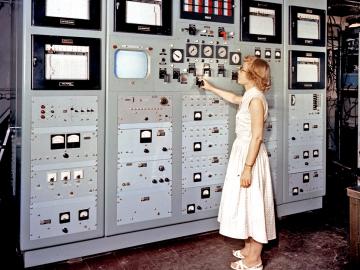
Filter News
Area of Research
- (-) Advanced Manufacturing (22)
- (-) Fusion and Fission (8)
- (-) Supercomputing (105)
- Biology and Environment (42)
- Building Technologies (2)
- Computational Biology (1)
- Computational Engineering (3)
- Computer Science (15)
- Energy Science (171)
- Fusion Energy (3)
- Isotope Development and Production (1)
- Isotopes (27)
- Materials (86)
- Materials for Computing (16)
- Mathematics (1)
- National Security (33)
- Neutron Science (35)
- Nuclear Science and Technology (17)
- Quantum information Science (6)
- Transportation Systems (2)
News Topics
- (-) 3-D Printing/Advanced Manufacturing (27)
- (-) Computer Science (96)
- (-) Cybersecurity (8)
- (-) Isotopes (3)
- (-) Mathematics (2)
- (-) Physics (9)
- (-) Space Exploration (4)
- (-) Transportation (8)
- Advanced Reactors (8)
- Artificial Intelligence (38)
- Big Data (22)
- Bioenergy (10)
- Biology (12)
- Biomedical (18)
- Biotechnology (2)
- Buildings (5)
- Chemical Sciences (9)
- Composites (4)
- Coronavirus (14)
- Critical Materials (4)
- Education (1)
- Energy Storage (11)
- Environment (23)
- Exascale Computing (27)
- Fossil Energy (1)
- Frontier (33)
- Fusion (24)
- Grid (7)
- High-Performance Computing (44)
- ITER (6)
- Machine Learning (16)
- Materials (22)
- Materials Science (24)
- Microscopy (8)
- Molten Salt (1)
- Nanotechnology (12)
- National Security (8)
- Neutron Science (16)
- Nuclear Energy (31)
- Partnerships (4)
- Polymers (2)
- Quantum Computing (20)
- Quantum Science (25)
- Security (6)
- Simulation (19)
- Software (1)
- Summit (43)
Media Contacts

Oak Ridge National Laboratory physicist Elizabeth “Libby” Johnson (1921-1996), one of the world’s first nuclear reactor operators, standardized the field of criticality safety with peers from ORNL and Los Alamos National Laboratory.

The Frontier supercomputer at the Department of Energy’s Oak Ridge National Laboratory earned the top ranking today as the world’s fastest on the 59th TOP500 list, with 1.1 exaflops of performance. The system is the first to achieve an unprecedented level of computing performance known as exascale, a threshold of a quintillion calculations per second.

A team of researchers has developed a novel, machine learning–based technique to explore and identify relationships among medical concepts using electronic health record data across multiple healthcare providers.

Tackling the climate crisis and achieving an equitable clean energy future are among the biggest challenges of our time.

A force within the supercomputing community, Jack Dongarra developed software packages that became standard in the industry, allowing high-performance computers to become increasingly more powerful in recent decades.

A study by researchers at the ORNL takes a fresh look at what could become the first step toward a new generation of solar batteries.

ORNL and the Tennessee Valley Authority, or TVA, are joining forces to advance decarbonization technologies from discovery through deployment through a new memorandum of understanding, or MOU.

A study led by researchers at ORNL used the nation’s fastest supercomputer to close in on the answer to a central question of modern physics that could help conduct development of the next generation of energy technologies.

Oak Ridge National Laboratory researchers recently used large-scale additive manufacturing with metal to produce a full-strength steel component for a wind turbine, proving the technique as a viable alternative to

More than 50 current employees and recent retirees from ORNL received Department of Energy Secretary’s Honor Awards from Secretary Jennifer Granholm in January as part of project teams spanning the national laboratory system. The annual awards recognized 21 teams and three individuals for service and contributions to DOE’s mission and to the benefit of the nation.


